A guide to exploring The Great Barrier Reef in Australia
Recognised as one of the seven wonders of the natural world, the Great Barrier Reef is one of the primary reasons why people visit Cairns. If it has been known to be visible from outer space, the magnificence of the world’s largest and most spectacular coral reef system will simply amaze you up close !
Cairns city is the gateway to the Great Barrier Reef. The best way to explore the Reef is by choosing a good tour company that will take care of all the logistics to ensure you have a memorable bucket-list worthy experience. It’s even better if you get to visit the outer Great Barrier Reef sites, because that’s where the best snorkeling and diving opportunities are. An incredible sea life in the warm and clear waters of the Great Barrier Reef await you. So this is your chance to spot some of the many species such as Nemo the Clownfish 🐠, Moorish Idol, Saddled Butterflyfish, Blue Tang Surgeonfish 🐟, Diagonal Lined Sweetlip, Coral Cod, Fantail Ray, Cuttlefish 🐡, everyone’s favourite Hawksbill or Green Sea Turtle 🐢, and if you’re lucky a shark or two 🦈.
In this post, I have shared my experience visiting the reef and the various activities that can be undertaken as part of the tour. The Great Barrier Reef can be experienced from the boat or in a semi-submarine, underwater by snorkeling or diving, parasailing across the Coral Sea, or on a scenic helicopter flight over the Reef. For a grand experience, you can even book a night or two staying out on the reef as part of a private charter. There are so many ways to experience the Great Barrier Reef and the choice is entirely yours!
On the tour day, one needs to make their way to the Reef Fleet Terminal located at Marlin Marina on 1 Spence Street and check in at the tour desk. Our cruise departed Cairns at 8:15am.

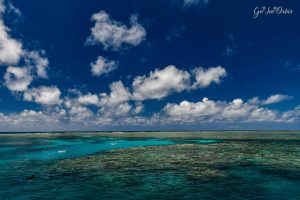


🚀 How to choose a good Great Barrier Reef Tour?
There are dime a dozen tour operators running tours to the Great Barrier Reef and the trick to selecting a good tour company is learning from the experience of previous travellers and weighing up the inclusions with the price of the tour.
We chose to go with the Evolution cruise which tends to visit two outer Great Barrier Reef destinations namely the Norman or Saxon and Hastings Reef. Evolution is a brand-new purpose-built state of the art high-speed 35 metre catamaran, with a cruising speed of 30 knots, providing comfort and safety for a maximum of 180 passengers. Their staff members were professional and friendly. They had good vegetarian food on board that included veg patties and a selection of eight different salads (four of them being vegan). Additionally, they served complimentary glasses of wine, cheese and crackers, and fruit platter on the return journey. My favourite aspect of the tour service was the professional photography they carried out throughout the day, both on board and underwater. Thanks to them, I managed to bring back home heaps of fantastic pictures of the Reef on that day, my underwater experience of snorkeling and diving, and they were kind enough to share the best Reef pictures they snapped throughout the year in a Micro SD card and also through AirDrop!
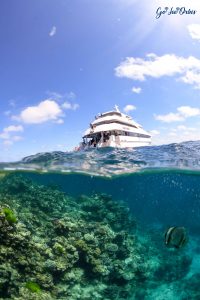
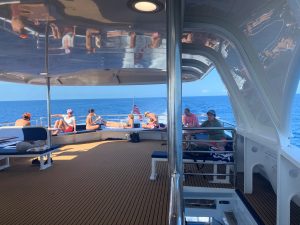
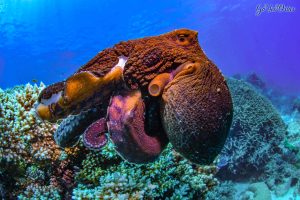

🚀 Snorkelling and Scuba Diving at the Great Barrier Reef
Snorkelling is included as part of the standard package and there are guides that will be happy to assist you with lifebuoys if you’re a first-timer. Snorkelling is an easy way to see the Reef’s colourful corals and fish species while mostly floating on the surface.
Briefing for divers starts almost immediately once the cruise sets sail which includes theory, practice, and application. If you have never dived before and are keen to try it out, you have an option to book an introductory dive beforehand or impromptu on board. The maximum depth covered is 10 metres which gives you a close view of the beautiful coral lagoons and a myriad of marine animals that don’t often come near the surface! You can even attend the briefing and request a free 5-minute introductory dive trial, before you take the plunge.
The tour operator provides all the snorkelling and diving equipment, including masks, flippers, wetsuits, tanks, weights, etc. So you only have to bring your swimmers and towel on the tour!
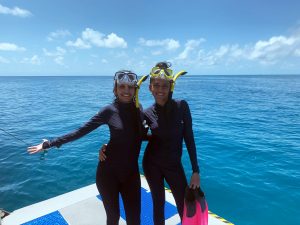


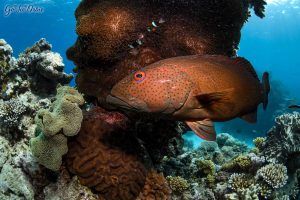
🚀 Do you need to know swimming to go scuba diving?
There is no correlation between swimming and scuba diving since scuba diving is done underwater and you don’t have to keep yourself above the water the way swimming works. Scuba diving is done in a neutrally buoyant state so you neither have to float or sink – you just breathe with your mouth and kicking with the flippers. Introductory dives have no more than 4 people per instructor making it reassuring for any first timers.
The three main skills we had to master were:
- Equalizing – Pinching your nose and blowing gently to force open the closed Eustachian tubes to minimise ear pain that occurs because of the underwater environment pressure. You have to Equalize often and gently when descending for the dive (preferably every 1 metre) or when changing the depth during the dive to prevent discomfort or ear injuries.
- Mask Clearing – In the instance where you face a partial or total mask flood, tilt your head back and look up, press the top part of your mask lens firmly to your forehead and let water out the lower seal.
- Regulator Recovery – If by chance your regulator knocks out of your mouth, you need to recover your regulator by exhaling slowly and continuously and blowing tiny bubbles, relocating your regulator using the sweep or reach method, replacing it back into your mouth, purge clearing with the button and saying TWO, and resuming normal breathing.
And remember that you must never hold your breath underwater. Holding your breath underwater can cause lung over-expansion injuries.
I personally enjoyed snorkelling more than diving, because as a regular swimmer it was finicky to carry a whole lot of heavy paraphernalia with me. I went through training and a practical session with the instructor underwater but goofed up the third skill. As a result, while I got busy gasping for air on the surface, the instructor carried on with the other 2 intro divers, leaving me by the boat (this is the funny story)! Lucky enough, I had another chance at the second reef site and I ensured I aced all the skills this time. It was a phenomenal experience, absolutely stupendous, but I was terrified when my ears started to pain intermittently (despite equalizing) and having to breathe just with the mouth. I think I’ve had my share of diving that will last me for a good while now! 😆
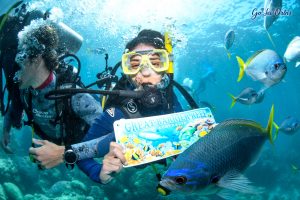
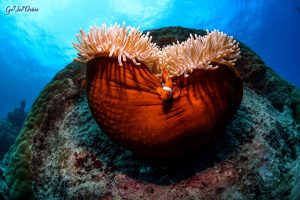
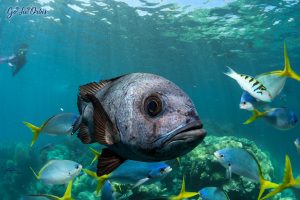
🚀 How much does it cost to visit the Great Barrier Reef?
We chose to go for the 2-day Reef and Rainforest package combo which included a full day tour to the Great Barrier Reef and a full day tour to the Daintree Rainforest and Cape Tribulation. which costed us AUD 330 (including 1x Intro Dive that comes with a completion certificate issued by Professional Association of Diving Instructors (PADI)).
There are some Reef tour optional extras you can add at an additional cost such as:
- Transfers from City: AUD 8.5 one way / AUD 17 return per person
- Transfers from Northern Beaches/Outer City: AUD 12 one way / AUD 24 return per person
- Certified Scuba Dive: Each dive takes up to 40 minutes and to a depth of up to 18 metres. Price is AUD 70 per dive payable on the day.
- Introductory Scuba Dive: Each dive takes up to 20 minutes and to a depth of up to 8 metres. Price is AUD 35 per dive payable on the day.
Note: Depending on your eligibility determined by your health condition and when your next flight is, you have the opportunity to undertake up to three dives per day during the tour. - Marine Biology Guided Snorkel Tour: Takes approximately 20 minutes. Price is AUD 25 payable on the day.
- SubXplorer Semi Submersible: At Hastings Reef and runs for approximately 20 minutes. Price is AUD 10 payable on the day.
- Helicopter Tour: 10-minute scenic flight over the Great Barrier Reef. Price is AUD 150.
- Digital underwater camera hire with SD card included. Price is AUD 55 per day.
- High Resolution images in Micro SD Card and AirDrop (All your own photos + On that day’s Reef’s pictures + Best of the year Reef’s photos). Price is AUD 50 for 1 person / AUD 80 for 2 people / AUD 100 for 3 people / AUD 120 for 4 people.

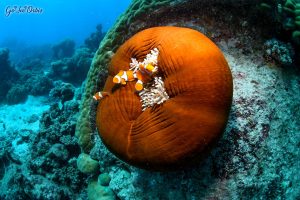
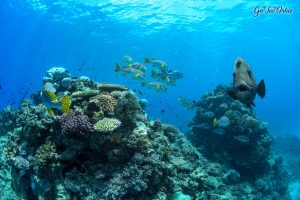
🚀 Is the Great Barrier Reef dying?
All the hype around climate change is alarming and concerns have funneled towards the Great Barrier Reef bleaching due to the carbon dioxide and other greenhouse gases accumulating in the atmosphere. However, it was somewhat relieving to hear from the locals (who access the Reef very often) that there is so much more than what meets the eye.
The Great Barrier Reef spans more than 2000 kilometers, has 3000 reef and coral cays, more than 1500 fish species, and 400 types of corals. Most of the coral species have a symbiotic relationship with the algae zooxanthellae. This algae lives inside the coral tissue and is responsible for giving corals majority of their nourishment so they don’t have to rely only on plankton. Moreover, it is the zooxanthellae living inside coral polyps that gives the gorgeous colours of the corals. So the presence of this algae allows the corals to weather the occasional bleaching event and help them quickly recover using the photosynthesized nutrients. This symbiosis however is at risk if further temperature changes continue as they are fairly heat sensitive. The coral polyps (the living part of coral) will have a harder time recuperating from bleaching events and might die, permanently causing changes in the ecosystem. Other types of algae will grow on bleached coral skeletons, driving away coral dependent species and attracting algae-eating species.
Having said that, it’s important to be mindful and vigilant of our environmental impacts. Whether we like it or not, even though bleaching is a normal phenomena, our actions do influence the coral reef ecosystems and the rate at which they regenerate. It is our collective duty to protect the Reef so they can be appreciated and marveled by many other people in the future. We can have a positive impact by choosing eco-certified travel operators, not touching or picking any corals or animals from the Reef, decreasing “single-use” plastic, and following the 3Rs – Reduce Reuse Recycle.

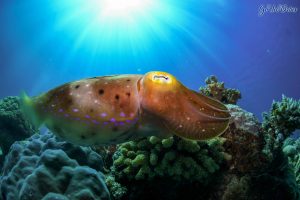

Excuse the puns 😜 but now that you have been schooled on visiting the Great Barrier Reef, seas the day and go explore it. Let minnow how you go about planning your trip and feel free to share your fintastic experiences with me! If you have any questions, just ask away ☺️

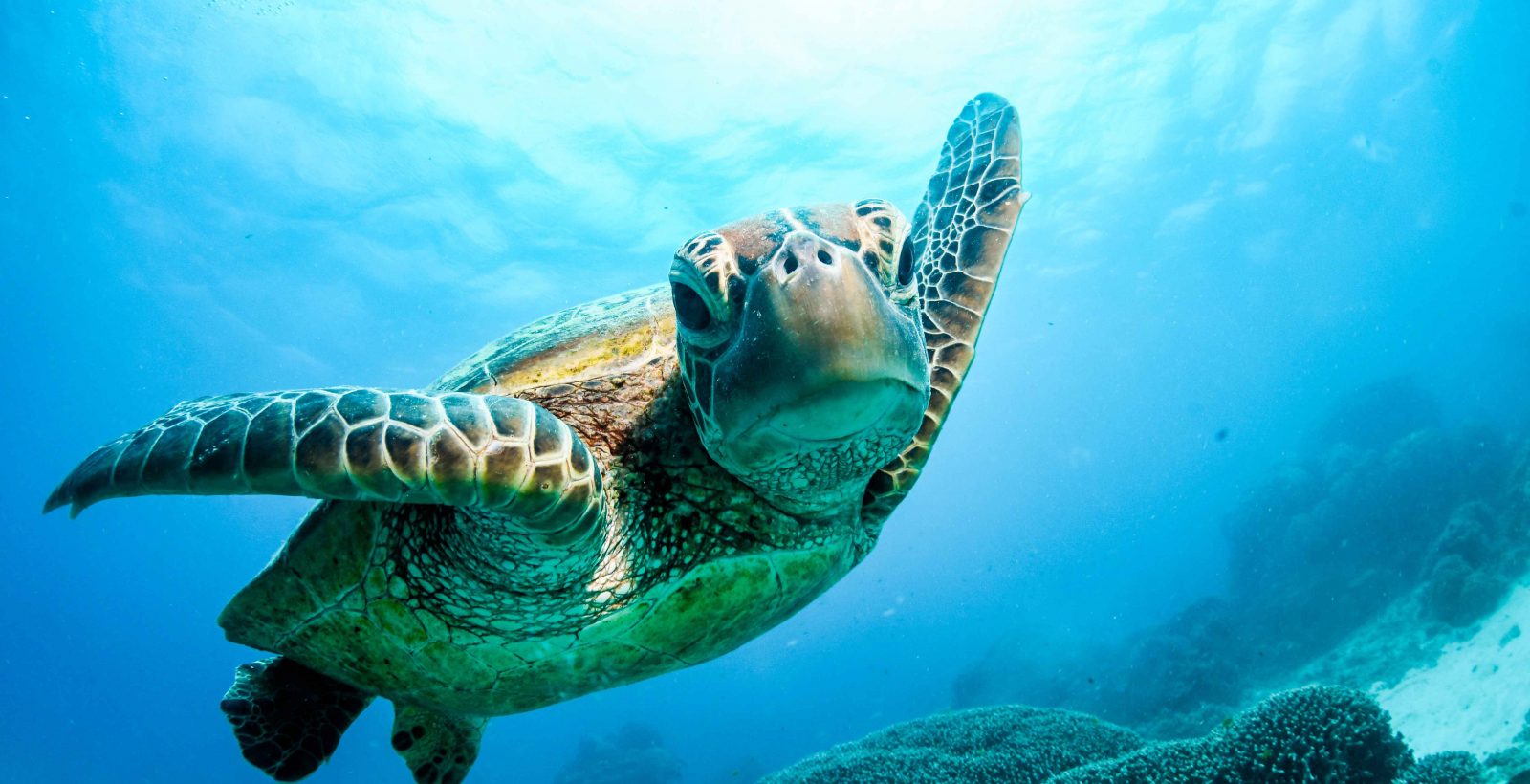
Beautifully composed. This was a life changing experience darling, many more to come with you haha 🙂
You aced scuba diving and amazed me! Many more diving experiences for you and more snorkelling for me 😆